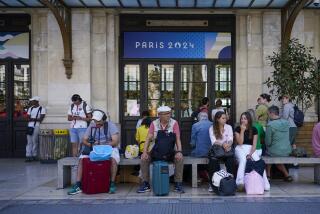Good Food, Fast Trains : France Has a Taste for Rail Travel
STRASBOURG, France — It is easy to lose one’s perspective while riding the trains of France. Several travelers, after finishing their foie gras, sampled some delicate scallops in the new dining car on the Paris-to-Strasbourg train the other night and wondered aloud if the cuisine was really up to three-star standard.
The answer, despite advance preparation of the dinner by one of France’s most celebrated chefs: probably not.
But the question reflects the expectations of travelers on the trains of France. Whether or not the food was worth three stars, it was probably better than on any other train in the world. Yet the diners had hopes for something even better.
Fastest in the World
France is one of the few countries left where trains compete with planes and cars as a wise and convenient way to travel from one region of the country to another. French trains are comfortable, efficient and fast. Some, in fact, are the fastest in the world.
“Look at the plane,” a child shouted some months ago, pointing through the window of the sleek TGV (as the Trains of Great Speed are called after their initials in French). Travelers could see a small, single-engine plane high in the sky, falling farther behind in its vain attempt to keep up with the train, which reaches 168 m.p.h. on the Paris-to-Lyon line. Although French writer Marcel Proust described the raptures of rail travel in loving detail in the early years of the century, there is no historical or cultural reason why France should still maintain an extensive and modern railway system.
French trains, for example, did not help unite the territory of France the way American trains helped turn a continent into a country.
In the Public Interest
But as part of an intensive program of rushing into the age of high technology, French officials decided in the 1970s that modernization of the railways was in the public interest--and might even be profitable. As a result, more passengers are attracted to French trains every year, and the railways have embarked on a program of significant expansion.
To be sure, there are problems with the French railway system. The railways, which are owned by the government, do not pay for themselves, though officials hope to make them break even by the end of the decade. A series of terrifying accidents killed 88 people last year, shocking France and forcing the president of the French Railways to resign. The accidents came after a near-perfect safety record for more than a decade.
Despite the problems, the French railroads are still the object of envy and longing for any American who might like the idea of speeding in comfort from Los Angeles to San Francisco in 2 hours and 15 minutes, or from New York to Washington in 1 hour and 23 minutes--with or without an almost-three-star meal.
Use of the sleek, bright-orange, electrically powered TGV, which began operations in 1981, is helped by the size of France, a small country when compared to the United States. On its first line, the TGV has cut in half, to two hours, the rail travel time for the 240 miles between Paris and Lyon, taking away 50% of the travelers who used to go by plane. The TGV also is one of the few operations of the French Railways that makes a profit.
There are plans to build TGV lines from Paris to Bordeaux on the Atlantic Coast and from Paris to Belgium and West Germany. Officials hope that once the English Channel tunnel is completed in the 1990s, the TGV can take passengers directly from Paris to London.
Filling the Luxury Gap
Although the TGV is fast, comfortable and efficient, it is not luxurious--a gap that the line seems intent on filling. Officials say that passengers, finding few advantages in first-class travel, were abandoning it in favor of second-class travel, and to stop this trend the railways inaugurated nouvelle premiere (new first class) as an experiment on its Paris-to-Strasbourg run eight months ago.
Since no TGV runs on this line, the railways also had to worry about airline competition.
A nouvelle premiere traveler, after waiting for his train in a special lounge that is isolated from the frenzy of the station, goes aboard first-class cars redesigned with salmon-and-black interiors and swivel chairs placed roomily apart in a variety of combinations that avoid the stereotyped rows or compartments usually found on trains. Some cars have computers programmed with games and information about hotels, restaurants and the French Railways. The train also has a bar, which looks more like a hotel cocktail lounge.
A passenger can break up the long trip with dinner in a special dining car, also decorated in salmon and black. It features a menu prepared in Paris under the supervision of Joel Robuchon, regarded by several gourmets as the finest chef in France. The food is refrigerated and vacuum-packaged in a process that avoids the tastelessness of frozen airline meals.
Among the choices for the first course are salad of foie gras with hearts of artichoke, smoked salmon with caviar and herb-spiced rounds of lobster. For the main course, there are scallops with cabbage, breast of chicken with foie gras, lamb chops with fresh herbs, and veal in white sauce.
The menu lists 13 red wines, five whites and a rose, but if the order is placed 24 hours in advance, a diner can have one of three special red Bordeaux that range in price from $109 to $188 a bottle. Dinner for two on the nouvelle premiere restaurant car, if an inexpensive red wine is ordered, comes to about $145, including the 15% tip.
The cost and all the hoopla of the Robuchon menu may be self-defeating. Many customers seem to feel slightly disappointed. The meal is better than any they have ever had on a train, but it is not quite up to the standards of a meal at that price in a Paris restaurant.
There seem to be some hitches in the system, perhaps stemming from its newness. Many travel agents forget to inform travelers that they must have reservations for the restaurant. On a recent evening, two travelers were turned away from a nearly empty dining car for lack of a reservation.
Nevertheless, French Railways are proud of the luxury of new first class travel. “We would like to put it on all our trains,” Gaston Kuhn, a railways spokesman, said in a recent interview.
But, although first class travel has increased by 5% on the Paris-Strasbourg line, he said it is still too early to tell whether the experiment was attracting enough first class passengers to call it successful.
Playground Cars
The French Railways have other special services to attract customers, including playground cars for children on some trains, package deals that cover not only train fare but hotel charges at various vacation sites and comfortable nights aboard sleeper cars.
The French Railways, which were nationalized in 1937, are regarded more as a public service than as a business. But under an agreement signed three years ago, the managers of the railways have promised that the trains will in general pay their own way by the end of the decade.
The government would still subsidize special programs, such as discounts for families traveling together, adequate services to the suburbs of Paris and small, special lines to serve isolated areas. But revenues would have to match costs for everything else.
Kuhn said the railways are heading toward this goal. The deficit, which came to 4.5 billion francs in 1985, was expected to drop to 3.9 billion francs ($565 million) this year. But the railways will have to reduce their staff by 8,000 workers in 1986 to accomplish this.
The accidents last year, which killed 88 people and injured 250, were caused by the errors of railroad workers. In one case, for example, a stationmaster, forgetting what time it was, signaled that a track was clear when it was not. In two other accidents, the engineers were going well beyond the speed limit. Andre Chadeau, the president of the railways, took responsibility for the accidents and resigned.
‘Relaxation of Standards’
“The accidents,” Kuhn said, “were probably caused by a relaxation of standards on the part of the officials in charge of safety. I have worked here for 40 years. I started when I was 17. And I know that these things happen in cycles.”
The last fatal accident had occurred a dozen years before.
Some analysts believe that the problem last year was caused by a loss of spirit among railroad workers, who are known as cheminots after chemin de fer, the French term for railroad. Cheminots once accepted a military atmosphere in which they followed all the rules blindly, according to this view, but modern workers no longer fit this mold.
Kuhn agreed, adding that the morale of the cheminots was a factor.
“When we used steam locomotives, each engineer had his own steam locomotive. I mean, it really was not his, but he acted as if it were. He came two hours early every day to prepare the locomotive for a trip. After an eight-hour day, he would stay behind for another hour to clean and shine it. When the engineer vacationed, his locomotive would not be used by anyone else but would go back into the yard for maintenance.”
Kuhn said all this came to an end when the steam locomotives were phased out. “Anyone could drive anyone else’s locomotive,” he said. “The work was banalized.”
More to Read
Sign up for The Wild
We’ll help you find the best places to hike, bike and run, as well as the perfect silent spots for meditation and yoga.
You may occasionally receive promotional content from the Los Angeles Times.






